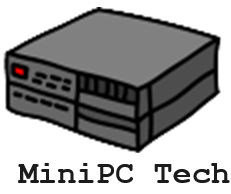
A Raspberry Pi is a small, affordable computer that you can use for various exciting projects. Its compact size and low power consumption make it perfect for home automation tasks, like controlling smart lighting or security cameras. You can also use it as a basic desktop for internet browsing and even run programs like LibreOffice for productivity. It’s great for education, helping you learn coding with languages such as Python. Plus, if you’re into robotics, you can build your own robots using it. The possibilities are endless, and there’s so much more to explore beyond these ideas!
Key Takeaways
- Raspberry Pi is a small, low-power single-board computer designed for various computing tasks and projects.
- It can be used for home automation, smart lighting, and security camera systems.
- Raspberry Pi supports multimedia tasks, capable of streaming video and running desktop applications.
- It serves as an educational tool, teaching programming and engaging students in STEM subjects.
- The device is versatile, allowing for innovative projects like automated pet care and DIY weather stations.
Overview of Raspberry Pi
Since its introduction, the Raspberry Pi has become a game-changer in the world of computing. With its small, single-board design, you can easily connect it to peripherals like a keyboard, mouse, and display, transforming it into a mini personal computer.
Despite being slower than traditional laptops or desktops, its low power consumption makes it an attractive option for various applications, from real-time image processing to robotics. The Raspberry Pi offers low power consumption compared to traditional computing devices, making it suitable for continuous operation in various projects. Additionally, the latest model (Raspberry Pi 5) features a powerful 2.4-GHz quad-core processor, which significantly enhances its performance for demanding tasks.
The Raspberry Pi history is rich, evolving through several series, including the flagship models, Zero, and Compute Module. This versatility has fostered a vibrant Raspberry Pi community, where enthusiasts and beginners alike share projects and ideas.
Whether you’re interested in home automation, creating a smart baby monitor, or even building an FM transmitter, there’s a project waiting for you.
You’ll find that the Raspberry Pi’s affordability and ease of use make it ideal for educational purposes, too. As you explore this innovative technology, you’ll discover countless possibilities to enhance your skills and connect with others who share your passion.
Join the Raspberry Pi community and see what amazing projects you can create!
Key Hardware Features
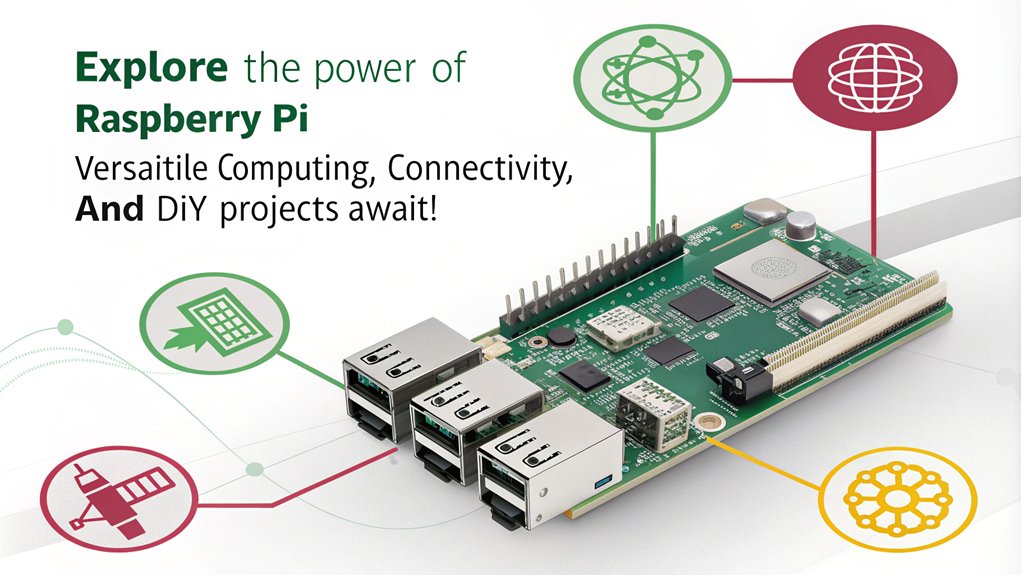
The Raspberry Pi’s innovative design is backed by impressive hardware features that enhance its functionality and versatility. At its core, you’ll find powerful processors like the Broadcom BCM2711 quad-core Cortex-A72 in the Raspberry Pi 4, reaching speeds up to 1.8GHz, or the BCM2712 Cortex-A76 in the Raspberry Pi 5, clocking in at 2.4GHz. These hardware specifications ensure you enjoy smooth performance, whether you’re running applications or exploring coding projects. Notably, the Raspberry Pi 5 is reported to be over twice as powerful as Pi 4, further emphasizing its upgraded capabilities.
In terms of memory, you can choose between various RAM options, with the Raspberry Pi 4 supporting up to 8GB of LPDDR4-3200 SDRAM, and the Raspberry Pi 5 offering LPDDR4X-4267 SDRAM. Storage is flexible too, thanks to a MicroSD card slot, optional eMMC, and USB-attached SSD storage.
Graphics capabilities are equally robust, featuring the VideoCore VII GPU in the Raspberry Pi 5, supporting 4K video at 60fps. With performance benchmarks that cater to multimedia tasks, the Raspberry Pi is perfect for creators and enthusiasts alike.
Whether you’re a hobbyist or a developer, these features make the Raspberry Pi a powerful tool for your projects.
Connectivity Options
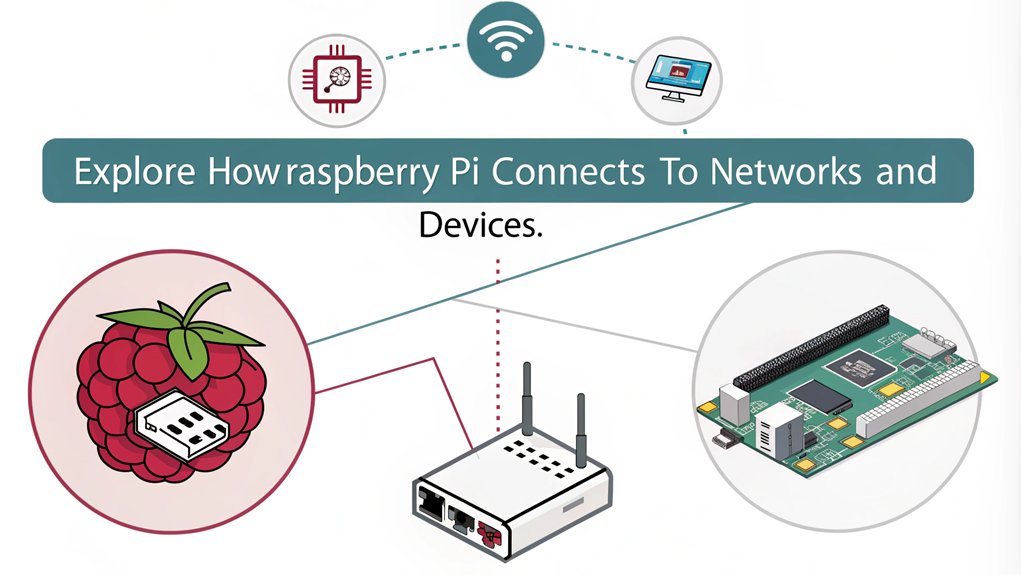
When it comes to connectivity options, Raspberry Pi offers a variety of ways to stay connected both online and to other devices. You can easily establish wired connections using the Ethernet port, which requires just an Ethernet cable plugged into a LAN port. This setup is straightforward, with the network usually detected automatically.
For a wireless setup, if you have a Raspberry Pi with built-in Wi-Fi or a wireless dongle, you can access the network icon in the menu bar to see available networks. Remember, for models like the Pi 3B+, you’ll need to set the country code first. Additionally, the transition to digital signals has influenced how Raspberry Pi communicates over networks. Furthermore, Raspberry Pi can connect to various smart devices and control them, enhancing your home automation experience.
Further, a Raspberry Pi can connect to nearby devices like mice, keyboards and speakers via Bluetooth.
Remote management is a breeze with SSH and VNC. You can enable SSH to access your Pi from another computer, or use VNC for a graphical interface. Both can be configured with simple commands, making remote access convenient.
Additionally, you can turn your Raspberry Pi into a network host. By using tools like ‘hostapd’, you can set it up as an access point, allowing other devices to connect to it. This flexibility makes your Raspberry Pi a great choice for various connectivity needs.
Using Raspberry Pi as a Desktop
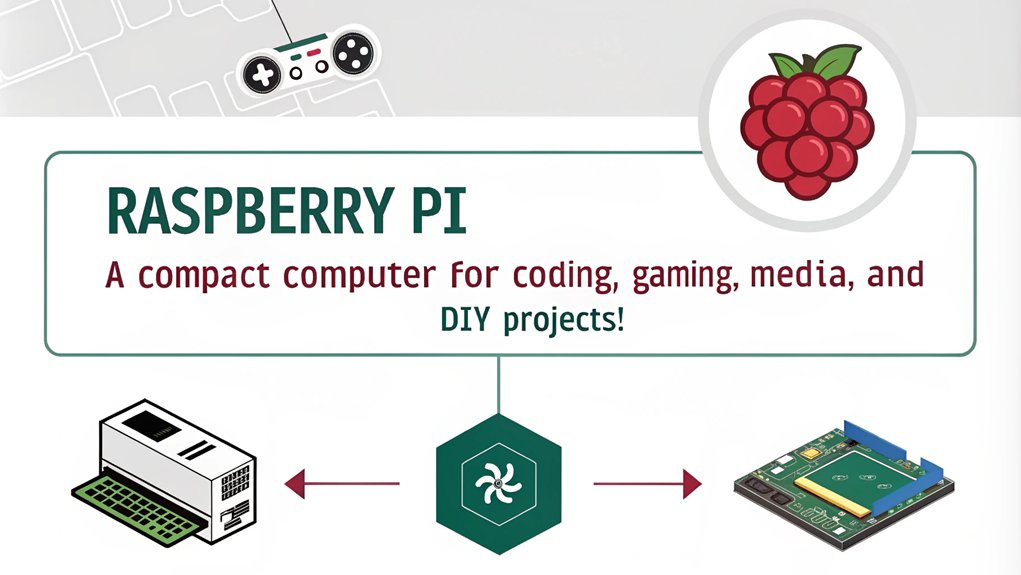
You can easily turn your Raspberry Pi into a functional desktop for basic computing tasks, internet browsing, and even streaming your favorite videos. With the right setup, it supports essential office applications, making it a versatile option for light work. The Raspberry Pi 4 B is capable of streaming YouTube up to 720p, which adds to its usability for multimedia tasks. Additionally, it can run lightweight applications that are optimized for Raspberry Pi’s limited resources, enhancing its overall performance. While it may not match the speed of traditional laptops, it’s a capable alternative for everyday use.
Basic Computing Tasks
For anyone looking to explore basic computing tasks, using a Raspberry Pi as a desktop can be an exciting and cost-effective solution. This versatile mini-computer can handle everyday tasks while also opening doors to more advanced projects like web development and gaming applications. Additionally, the Raspberry Pi features GPIO pins for hardware interfacing, allowing you to incorporate physical components into your projects.
To get started, you’ll need a few essential components:
- Raspberry Pi board
- MicroSD card
- USB keyboard and mouse
Once you have the hardware set up, install Raspberry Pi OS, which is a modified version of Linux. This operating system comes with the XFCE4 desktop environment, providing a user-friendly interface. You can also create and manage files using commands like ‘touch’ for file creation, which is a helpful tool for organizing your projects.
With tools like LibreOffice for office tasks and Visual Studio Code for development, you can efficiently manage your workload.
You’ll also find compatibility with various applications, such as:
- Thunderbird for email
- Brave for web browsing
- VLC for movie playback
The integrated calendar in Thunderbird and customizable dock in XFCE4 enhance your productivity.
Whether you’re managing emails or diving into gaming applications, your Raspberry Pi can serve as a reliable desktop for all your basic computing needs.
Internet and Streaming
Building on the capabilities of your Raspberry Pi as a desktop, it can easily connect to the internet, enhancing your computing experience significantly.
With support for both 2.4GHz and 5GHz WiFi networks, you can enjoy high-definition streaming and seamless internet browsing. Plus, by configuring it as a Raspberry Pi router, you can share internet connections and utilize internet bonding for faster, more reliable access. Additionally, your Raspberry Pi can function as a wireless bonding router, combining multiple Internet connections for improved speed and stability. A well-optimized Plex Media Server can significantly enhance your streaming experience by organizing and delivering content effectively.
Your Raspberry Pi can serve as a dedicated streaming server using streaming protocols like RTMP, HLS, and SRT. This means you can set up webcam integration for live video streaming or even engage in video restreaming to social networks.
Whether you’re looking to create an IRL streaming backpack or host live streams on your website, your Raspberry Pi supports mobile live streaming with stable connections.
For enhanced network security, you can utilize channel bonding VPN with Speedify, ensuring your connections remain secure.
With these features, your Raspberry Pi becomes a powerful tool for various streaming projects, allowing you to connect, share, and create in an engaging digital community.
Office Applications Support
Raspberry Pi frequently proves to be a versatile desktop alternative, especially when it comes to office applications. With tools like LibreOffice, you can tackle a variety of tasks without breaking the bank. This free and open-source office suite often comes pre-installed with Raspbian and includes:
- A robust word processor
- Powerful spreadsheet applications
- Presentation and image editing tools
To get started with LibreOffice installation, simply update your packages with ‘sudo apt update’, followed by ‘sudo apt install libreoffice’. Additionally, it is recommended to use the latest Raspberry Pi OS for the best performance while using LibreOffice. Moreover, installing LibreOffice requires additional disk space of 649 MB post-installation to accommodate the software.
Alternatively, you can use Pi-Apps for a smoother installation experience. If you’re looking for office suite alternatives, consider Abiword for word processing or Gnumeric for spreadsheets. These options can easily be installed via the command line.
You can also enjoy Google Docs usage directly from your browser, offering a seamless online experience. Just be sure to install compatible fonts to avoid formatting woes.
Whether you’re drafting a document or crunching numbers, Raspberry Pi can support all your office needs efficiently while fostering a sense of community among fellow users.
Home Automation Applications
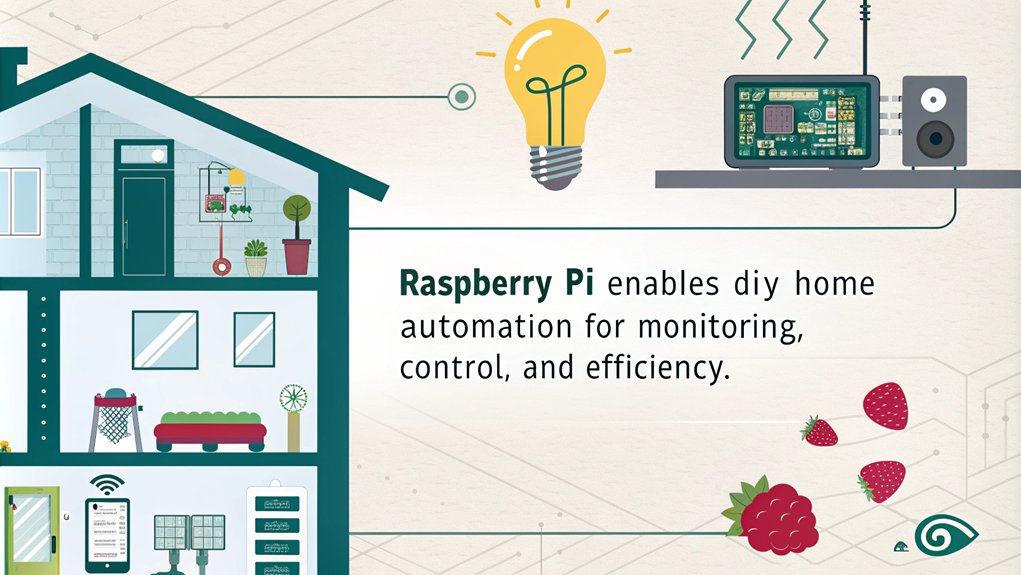
With a Raspberry Pi, you can easily control smart lighting, set up security camera systems, and automate your thermostat. These applications not only enhance your home’s convenience but also improve energy efficiency and security. Additionally, by using Home Assistant, you can integrate various devices and platforms to create a more comprehensive smart home system. One effective method to enhance your security camera setup is to connect PIR motion sensor to your Raspberry Pi, which can trigger alerts when motion is detected. Let’s explore how you can implement these solutions effectively.
Smart Lighting Control
Smart lighting control systems transform your home into an intelligent environment, seamlessly adapting to your needs. With Raspberry Pi, you can create a networked lighting system that responds to your actions and preferences. By incorporating LED integration and motion detection, you’ll enjoy a more efficient and dynamic space.
Here’s what you can achieve:
- Voice automation: Control your lights hands-free with Google Assistant or Alexa.
- Smart hubs: Connect your system to hubs like Philips Hue or LIFX for enhanced functionality.
- Sensor triggers: Automate your lighting based on motion detection using PIR sensors. Additionally, you can enhance home security through automated lighting setups that deter potential intruders. The Raspberry Pi serves as a versatile platform for integrating various smart devices into your lighting system.
Setting this up involves some circuit wiring and programming scripts. You’ll need Raspberry Pi, LED lights, resistors, and a reliable network connection.
The GPIO library in Python allows for easy control of your lighting, while Home Assistant offers a user-friendly interface for managing your devices. Plus, integrating with IFTTT can streamline your home automation experience.
With these tools, you can create a smart lighting system that not only enhances your home but also brings a sense of belonging and comfort to your everyday life.
Security Camera Systems
Home automation extends beyond lighting control; it also encompasses security solutions that provide peace of mind. With a Raspberry Pi, you can set up a cost-effective security camera system that utilizes camera management and motion detection to keep your home safe. One crucial component of this system is the Raspberry Pi HUB, which connects multiple cameras for centralized monitoring. The Internet of Things (IoT) has made it easier than ever to integrate various devices into a cohesive system.
Here’s a quick overview of what’s involved:
| Aspect | Details |
|---|---|
| Hardware Needed | Raspberry Pi, camera module, power source |
| Software Options | MotionEye, Shinobi, ZoneMinder |
| Network Setup | Local network connection, optional port forwarding |
| Storage Solutions | External drive for video footage |
| User Interface | Web browser access with secure login |
Once you have the hardware set up, you can easily add cameras using MotionEye. This software allows you to manage multiple cameras, configure motion detection settings, and even receive alerts via SMS or email. You can customize the system to suit your specific needs, whether it’s monitoring your front porch or keeping an eye on the backyard. With community support and extensive resources available, you’ll feel empowered to create a reliable security system tailored to your home.
Thermostat Automation Solutions
Thermostat automation solutions offer a seamless way to manage your home’s heating and cooling, ensuring comfort while maximizing energy efficiency.
With a Raspberry Pi, you can take control of your thermostat programming, allowing for precise temperature monitoring and effective heating control.
- Set multiple schedules for different days of the week
- Monitor temperatures remotely via a web interface
- Integrate with other smart home devices for enhanced automation
Using 1-wire temperature sensors, like the DS18B20, you’ll get accurate readings to maintain your desired climate.
You can create custom heating programs and easily switch between manual and automated modes. Plus, with real-time updates and alerts sent through Telegram Messenger, you won’t miss a beat.
The system’s flexibility lets you adjust settings based on forecasts, ensuring that your home stays cozy even during unexpected cold spells.
By customizing your setup with open-source software like Home Assistant, you can tailor it to fit your unique needs.
Embrace the future of home automation and enjoy the peace of mind that comes with efficient, smart heating control.
Robotics and Control Projects
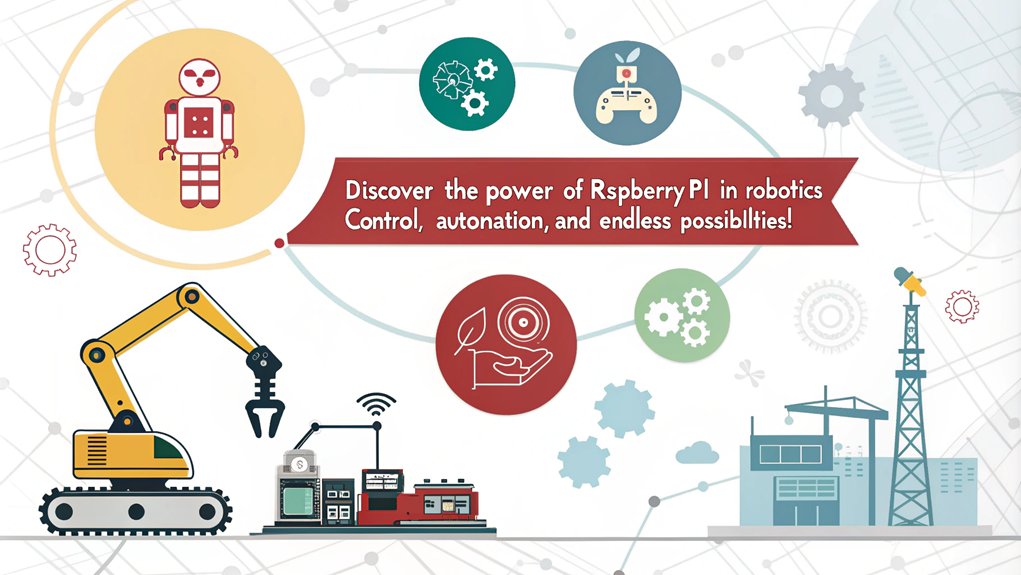
Dive into the exciting world of robotics and control projects with Raspberry Pi, where creativity meets technology. You can build incredible robots using various kits that harness the power of programming languages like Python. Let’s explore some options:
| Kit Name | Key Features | Ideal For |
|---|---|---|
| SunFounder PiCar-X | Obstacle avoidance, face detection | Beginners and hobbyists |
| Adeept RaspTank | 4-DOF robotic arm, object recognition | Intermediate learners |
| XRP | Open coding environment for wheeled robots | Aspiring engineers |
| Petoi Bittle Robot Dog | AI applications, voice control, ROS integration | Advanced robotics enthusiasts |
These platforms enable you to dive into tasks like line tracking and autonomous movement, enhancing your skills in robotics. With the integration of intelligent camera modules and ultrasonic sensors, you can develop robots that recognize objects and avoid obstacles. Plus, you can implement AI applications for even more sophisticated functionalities. Whether you’re interested in programming voice control or experimenting with object recognition, Raspberry Pi opens the door to endless possibilities in robotics. Join a community of creators and start your journey today!
Innovative Project Ideas
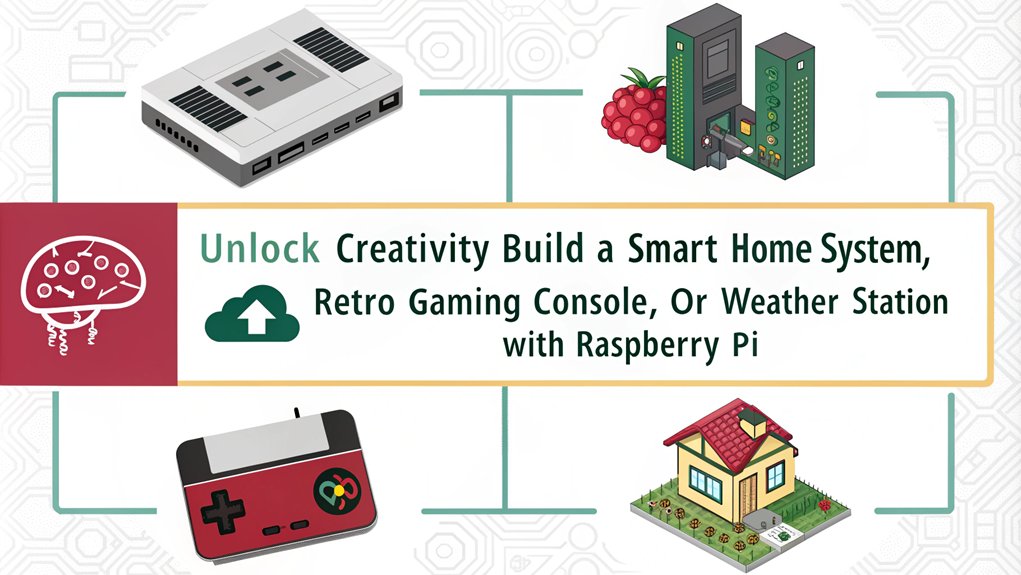
Unleashing your creativity with Raspberry Pi opens up a world of innovative project ideas that can transform your living space.
Whether you want to enhance convenience, monitor your environment, or care for your pets, there’s something for everyone. Here are a few ideas to get you started:
- Automated Pet Care: Design a smart cat feeder that uses machine learning to automate feeding times and monitor your furry friend through a camera.
- Environmental Monitoring: Create a weather station to track changes in temperature and humidity, keeping your home comfortable and efficient.
- Personal Assistant: Build a DIY robot that delivers snacks and drinks, complete with voice recognition for hands-free operation.
These innovative robotics projects not only simplify your daily tasks but also integrate seamlessly into your lifestyle, fostering a sense of belonging and efficiency.
With Raspberry Pi, you can explore endless possibilities and bring your ideas to life, making your home smarter and more enjoyable.
Educational Uses and Resources
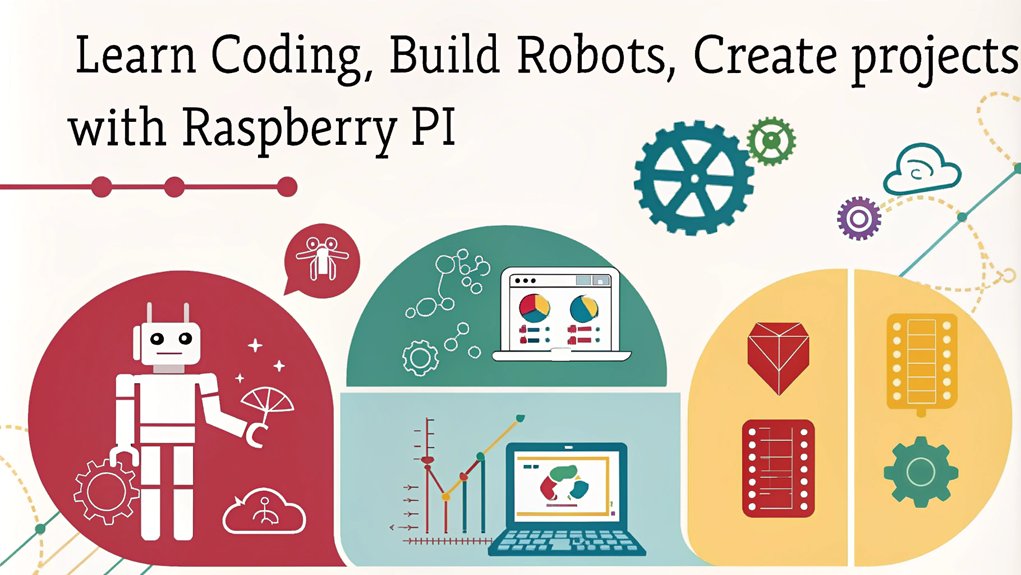
With the creative potential of Raspberry Pi projects in mind, it’s clear that this versatile device also plays a significant role in education. You can easily integrate it into your curriculum, enhancing student engagement across subjects like physics, biology, and electronics.
By using programming languages such as Scratch and Python, students not only develop valuable coding skills but also engage in critical thinking through project customization. The affordability and ease of use make Raspberry Pi accessible for classrooms, allowing you to set up projects without hassle.
Plus, when students own their Raspberry Pis, they’re more emotionally invested in their learning. To support this journey, the Raspberry Pi Foundation offers robust educational outreach and teacher training, ensuring you have the resources needed to guide your students effectively.
You’ll also find a wealth of community resources, including forums and pre-designed schemes of work, helping you connect with other educators and share best practices. By leveraging these tools, you can create an enriching learning environment that fosters creativity and collaboration, empowering your students to explore the exciting world of computing.
Getting Started With Raspberry Pi
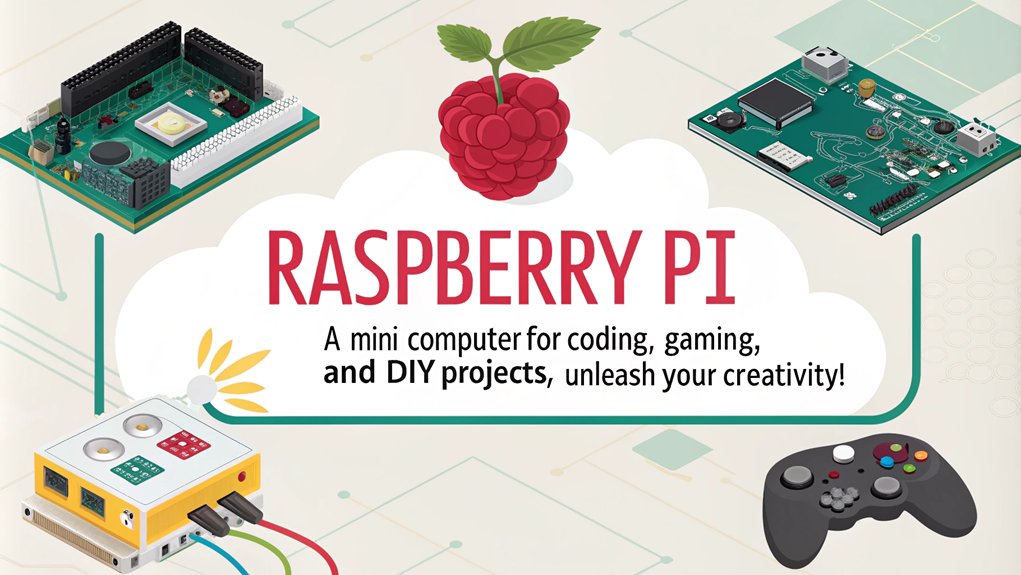
Getting started with your Raspberry Pi opens up a world of possibilities for creativity and learning. To embark on this exciting journey, you’ll need to gather a few essential hardware components:
- A microSD card with ample storage and speed
- An HDMI monitor or smart tv, keyboard, and mouse
- A suitable micro USB power supply (5.1V / 2.5A)
Once you have everything, follow the installation process. If using NOOBS, simply insert the microSD card into the Raspberry Pi’s card slot, connect your peripherals, and power it up. It should boot within 15-20 seconds.
Make sure to pay attention to the peripherals connection; unplug the power supply before connecting any devices.
After setting up, follow the on-screen instructions to configure your network and user account.
During this boot setup, ensure your Raspberry Pi operates within the recommended operating temperature of 0°C to +50°C for optimal performance.
With these steps, you’ll be well on your way to unleashing the full potential of your Raspberry Pi, where learning and innovation await!
Frequently Asked Questions
Can Raspberry Pi Run Windows Operating Systems?
Yes, you can run Windows on your Raspberry Pi, but compatibility’s limited. Raspberry Pi OS typically offers better performance and support. Experimenting with Windows can be fun, but it’s not always practical for daily use.
What Power Supply Specifications Are Needed for Raspberry Pi?
For your Raspberry Pi, ensure you use a power adapter that meets its power requirements. Different models need specific voltages and currents, so check compatibility to avoid instability or damage while enjoying your projects.
Is Raspberry Pi Suitable for Gaming?
Raspberry Pi gaming can be exciting! You can dive into retro gaming by emulating classic consoles, enjoying 8-bit adventures and arcade classics. Just remember, performance varies, so choose your games wisely for the best experience.
How Do I Connect Raspberry Pi to Wifi?
Imagine a bridge connecting you to a digital world. For WiFi setup, use the Raspberry Pi Imager or desktop interface. If you face network troubleshooting, the terminal’s your trusty map to navigate through!
Can I Use Raspberry Pi for Machine Learning Projects?
Yes, you can use Raspberry Pi for machine learning projects, especially in image processing and neural networks. While it’s not as powerful as advanced boards, it’s perfect for running lighter models and exploring new ideas.
Conclusion
In summary, whether you’re diving into desktop computing or exploring robotics, the Raspberry Pi offers endless possibilities. It’s a tiny powerhouse that can transform your ideas into reality, bridging the gap between simple projects and complex systems. You might be surprised at how much you can accomplish with such a compact device. So, why not unleash your creativity and start your journey with Raspberry Pi today? The only limit is your imagination!

I am a retired software engineer with experience in a multitude of areas including managing AWS and VMWare development environments. I bought a relative a mini-PC a year ago and have become passionate about the technology and its potential to change how we deploy software.
